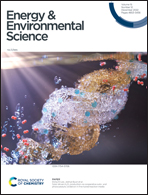Material and energy requirements of transport electrification†
Abstract
The replacement of internal combustion engines by electric vehicles (EVs) is being promoted towards the decarbonisation of the transportation sector. EVs require important amounts of materials, some of which are being assessed as potentially critical in the future. In this work, we develop a submodule of material requirements for transport for an integrated assessment model with great detail in the representation of electric transportation modes. This submodule includes the following novel characteristics: a portfolio of EV battery subtechnologies (LMO, NMC622, NMC811, NCA & LFP) and EV chargers, including the required connections to the grid; comprehensive coverage of their material intensities; and a dynamic allocation function for EV battery subtechnologies, taking into account the changes over time of their Energy Stored Over energy Invested (ESOI) and material scarcities. We obtain ESOIst levels for household 4-wheelers in the range of 1.1–2.3 : 1 depending on the subtechnology, and lower than 1 : 1 for all subtechnologies when expanding the boundaries (ESOIfinal) to include grids and chargers. The NCA and NMC subtechnologies are the best performing options in terms of ESOI; however, they are more dependent on critical materials such as nickel, cobalt and manganese. Expanding the boundaries to include chargers significantly increases the GHG footprint of EVs. The integration of these features into a dynamic modelling framework, including the demand of materials from the rest of the economy, allows us to analyse different decarbonisation strategies, taking into account the feedback between the energy and material dimensions. Simulating the MEDEAS-World model including the developed submodule until 2050 for 3 different global transport transition strategies, we find that reserves of copper (with significant contributions from EV chargers and railways), cobalt, lithium, manganese, nickel and graphite would be depleted in at least one of the scenarios studied. The Degrowth scenario puts less pressure on material endowments. Recycling is an important strategy to reduce criticalities, but its effectiveness is limited as the materials are trapped for long time periods in stocks in-use in the system, which is worsened by the growth-oriented nature of the current economic paradigm.



 Please wait while we load your content...
Please wait while we load your content...